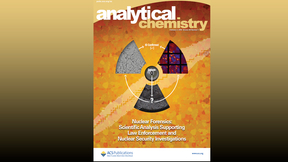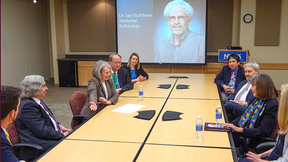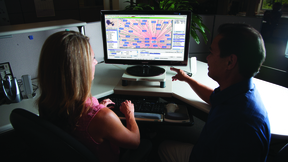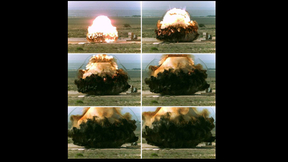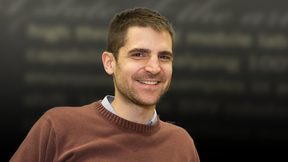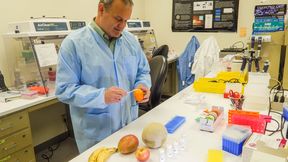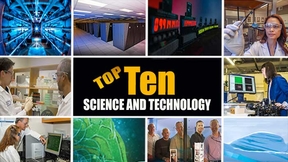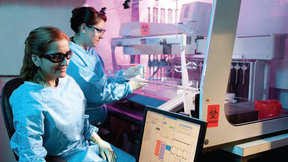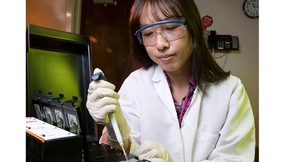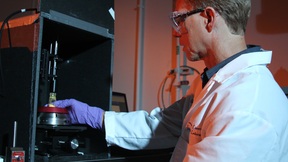Back
A Lawrence Livermore National Laboratory (LLNL) team played a key role in fielding the recent Source Physics Experiment (SPE-5) detonated at the Nevada Nuclear Security Site (NNSS).The SPE shots, including the most recent one on April 26, consist of a series of six underground high-explosive detonations in hard rock that are designed to improve the United States’ ability…
Two Laboratory scientists have teamed with Australian colleagues to author an overview of nuclear forensics that is featured as the cover story for the Feb. 2 edition of Analytical Chemistry magazine.LLNL analytical chemists Mike Kristo and Ruth Kips, in collaboration with three researchers from the Australian Nuclear Science and Technology Organisation (ANSTO), wrote the…
Energy Secretary Ernest Moniz last Thursday awarded the first Office of Defense Nuclear Nonproliferation (DNN) fellowship in honor of the late Ian Hutcheon, a longtime nuclear forensics expert at Lawrence Livermore National Laboratory, to Thomas Gray.Gray serves as a nonproliferation graduate fellow in the National Nuclear Security Administration’s Office of Defense…
Researchers from five laboratories and a private company recently spent two days in blistering 100 degree heat testing radiation detection technologies amidst cargo containers.The 15 researchers demonstrated the feasibility of using gamma-ray and neutron imaging detectors to identify radioactive materials using the Laboratory’s cargo container stack testbed."The purpose of…
Anne Harrington, the National Nuclear Security Administration's (NNSA) deputy administrator for Defense Nuclear Nonproliferation, recently presented the NNSA Excellence Medal to Leon Berzins for the successful Source Physics Experiment 4 Prime (SPE4) campaign at the Nevada National Security Site (NNSS).The experiments, designed to provide a better understanding of seismo…
Government agencies, along with state and local governments, could receive a helping hand from a computer network security tool developed by Lawrence Livermore National Laboratory (LLNL) computer scientists and engineers. The LLNL software-based technology, known as the Network Mapping System (NeMS), has been licensed to Cambridge Global Advisors, a Washington, D.C.-area…
Researchers from LLNL and three other institutions have assisted a Bay Area biomedical company in advancing its Ebola virus detection test for use.Sunnyvale-based Cepheid has received an emergency use authorization from the U.S. Food and Drug Administration (FDA) to utilize its polymerase chain reaction (PCR)-based assay for diagnostic purposes."We received a Cepheid…
Lawrence Livermore researchers have determined that a tunnel bomb explosion by Syrian rebels was less than 60 tons as claimed by sources.Using seismic stations in Turkey, Livermore scientists Michael Pasyanos and Sean Ford created a method to determine source characteristics of near-earth surface explosions. They found the above-ground tunnel bomb blast under the Wadi al…
Agricultural officials who seek to detect diseases affecting the commercial swine industry may gain a new ally — a biological detection system developed by Lawrence Livermore National Laboratory (LLNL) researchers.A study by LLNL and Kansas State University scientists found that the Lawrence Livermore Microbial Detection Array (LLMDA) could help identify diseases in the…
Editor's note: This article is part of an occasional series about LLNL entrepreneurs_______________Martin Casado considers himself to be an accidental entrepreneur.The 38-year-old Bay Area tech executive went from a research career at Lawrence Livermore National Laboratory to a doctorate at Stanford University, to starting and selling a company and finally to his current…
A spring workshop in the nation’s capital earlier this month provided an auspicious start for LLNL’s Jeff Drocco and other participants in the Emerging Leaders in Biosecurity Initiative program.Drocco is one of 28 fellows — selected from nearly 100 applicants — participating in the program at the Center for Biosecurity, which is operated by the University of Pittsburgh’s…
Fans of the popular TV series "CSI" know that the forensics experts who investigate crime scenes are looking for answers to three key questions: "Who did it; how did they do it; and can we stop them from doing it again?"The field of nuclear forensics, an important element of LLNL’s national security mission, has similar goals and uses similar techniques — but with even…
LIVERMORE, California – Foodborne illnesses kill roughly 3,000 Americans each year and about 1 in 6 are sickened, according to the Centers for Disease Control and Prevention. Yet most contaminated foods are never traced back to their source. That’s because existing methods to track tainted food following its supply chain from table to farm are highly inefficient,…
In 2014, Lawrence Livermore National Laboratory (LLNL) built on a 62-year tradition of translating basic science into technologies that ensure national security, address pressing real world problems and expand the boundaries of fundamental science.The top stories of the year are a reflection of the Laboratory’s ability to apply its core national security competencies to a…
For the second time, Lab physicist Roger White, a designer in B-Division from the Weapons and Complex Integration (WCI) Directorate, has received an award from the Defense Threat Reduction Agency (DTRA) for his work in post-detonation nuclear forensics.White was named the "top contributor of the quarter" for the third quarter of the fiscal year 2013 (April-June, 2013) for…
LIVERMORE, Calif. - Researchers from Lawrence Livermore National Laboratory (LLNL) and the Swiss Federal Institute of Technology (ETH) in Zurich have developed a new method of using nanotubes to detect molecules at extremely low concentrations enabling trace detection of biological threats, explosives and drugs. The joint research team, led by LLNL Engineer Tiziana Bond…
Lawrence Livermore National Laboratory (LLNL) has again received recognition this year for its work to move breakthrough technologies into the commercial marketplace.Livermore researchers and tech transfer professionals garnered four awards in the Federal Laboratory Consortium's (FLC) Far West Regional competition.This year's awards, presented last week during the FLC's…
Over the last 50 years, scientists from Lawrence Livermore National Laboratory's (LLNL) Biosciences and Biotechnology Division (BBTD) have changed the world by being instrumental researchers on the Human Genome Project, developing high-tech devices to sort cells and analyze DNA and providing the science for federal programs to defend the nation from biological weapons…
A team of Lawrence Livermore National Laboratory (LLNL) researchers has pioneered the use of a long-standing technology for a new application -- analyzing the chemical composition of uranium samples.In a paper published as the cover story in the September edition of Applied Spectroscopy , the Laboratory scientists describe the first reported use of near-infrared…
A Lawrence Livermore National Laboratory (LLNL)-developed biological detection technology has been employed as part of an international collaboration that has detected a virus in bladder cancers.The research, performed in conjunction with scientists from the University of Split in Croatia, LLNL and the University of Jordan in Amman is believed to be the first study to…


